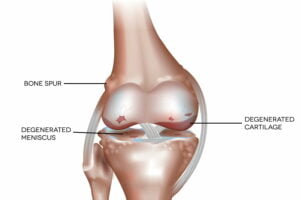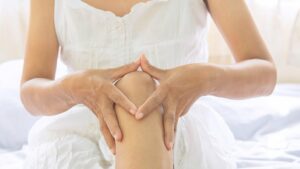Knee pain can be a formidable adversary, affecting women of all ages and backgrounds. In a world where women are consistently on the move, the significance of addressing knee pain goes beyond physical discomfort—it’s a matter of preserving women’s vitality and quality of life. In this article, we delve into the complex world of knee pain in women, exploring its causes, prevention strategies, treatment options, and holistic approaches to foster better knee health.
Contents
Understanding Knee Anatomy

Understanding knee anatomy is crucial for comprehending how the knee joint functions and how various knee-related issues can arise. The knee is a complex joint that connects the thigh bone (femur) to the shin bone (tibia). It is responsible for supporting body weight, facilitating movement, and providing stability. Let’s break down the key components of knee anatomy:
Bones:
- Femur: The upper leg bone that forms the top portion of the knee joint.
- Tibia: The larger of the two lower leg bones, forming the bottom portion of the knee joint.
- Patella: Commonly known as the kneecap, this small, flat bone rests in front of the knee joint and helps protect it.
Articular Cartilage:
- Femoral Condyles: The rounded portions at the lower end of the femur that articulates with the tibia. These are covered with a smooth layer of articular cartilage, which helps reduce friction and allows smooth movement within the joint.
- Tibial Plateau: The top surface of the tibia that articulates with the femoral condyles. It is also covered in articular cartilage.
Common Causes of Knee Pain in Women
Knee pain in women can be caused by a variety of factors, ranging from biomechanical differences to hormonal influences. Some common causes of knee pain in women include:
- Patellofemoral Pain Syndrome (PFPS): Also known as “runner’s knee,” PFPS involves pain around the patella (kneecap) due to improper tracking of the patella over the femur. It can be caused by muscle imbalances, overuse, and activities that involve repetitive knee bending, such as running and squatting.
- Anterior Cruciate Ligament (ACL) Injuries: Women are more prone to ACL injuries due to factors like hormonal differences, muscle imbalances, and the angle at which the femur meets the tibia. ACL injuries often occur during sports that involve sudden stops, changes in direction, and jumping.
- Meniscus Tears: The menisci are cartilage structures that cushion the knee joint. Tears can occur due to sudden twisting movements or degeneration over time. Activities like sports or jobs that require repeated squatting and twisting can increase the risk of meniscus tears.
- Osteoarthritis: This is a degenerative joint disease that can cause knee pain, stiffness, and reduced range of motion. Women are generally more prone to osteoarthritis, especially as they age.
- Iliotibial (IT) Band Syndrome: The IT band is a fibrous tissue that runs along the outside of the thigh and can become tight or inflamed, causing pain on the outer side of the knee. Activities like running or cycling can exacerbate IT band syndrome.
- Patellar Tendinitis: Also called “jumper’s knee,” this condition involves inflammation of the patellar tendon, which connects the patella to the tibia. Repetitive jumping and landing activities can contribute to this condition.
- Bursitis: Bursae are small fluid-filled sacs that cushion and reduce friction between tissues in the knee joint. Inflammation of the bursae, known as bursitis, can cause pain and swelling. Activities that involve frequent kneeling or prolonged sitting with the knees bent can lead to bursitis.
- Hormonal Fluctuations: Hormonal changes during the menstrual cycle can influence the laxity of ligaments and the stability of the knee joint. Some women may experience increased knee pain during certain phases of their cycle.
Lifestyle and Prevention

Lifestyle and preventive measures play a crucial role in maintaining healthy knees and reducing the risk of knee pain and injuries. Here are some lifestyle tips and strategies to consider:
- Maintain a Healthy Weight: Excess body weight puts additional stress on the knees, increasing the risk of knee pain and joint problems. Maintaining a healthy weight through a balanced diet and regular exercise can help reduce this risk.
- Stay Active: Engage in regular physical activity to keep the muscles around the knee joint strong and flexible. Low-impact exercises like walking, swimming, cycling, and yoga can be beneficial for knee health.
- Warm-Up and Stretch: Before engaging in exercise or physical activity, warm up with gentle movements and then perform dynamic stretches. After the activity, include static stretches to maintain flexibility.
- Proper Footwear: Wear shoes that provide adequate support and cushioning, especially when engaging in activities that involve impact. Proper footwear can help promote proper alignment and reduce stress on the knees.
- Core and Hip Strengthening: Strong core and hip muscles help support proper body mechanics, which in turn can help reduce strain on the knees.
- Maintain Good Posture: Proper posture while sitting, standing, and walking can help distribute body weight more evenly and reduce the risk of knee pain.
- Avoid High Heels: Limit the use of high-heeled shoes, as they can alter knee alignment and contribute to knee pain.
- Use Proper Technique: When engaging in sports or exercise, use proper techniques to avoid putting excessive stress on the knees. This is especially important for activities that involve jumping, pivoting, or sudden changes in direction.
Managing Knee Pain: Treatment Options
Managing knee pain involves a combination of self-care strategies, lifestyle modifications, and medical interventions, depending on the underlying cause and severity of the pain. Here are various treatment options for managing knee pain:
- Rest: Allow your knee to rest and avoid activities that exacerbate the pain. Give your knee a break to prevent further irritation and promote healing.
- Ice: Applying ice to the affected area can help reduce inflammation and alleviate pain. Use an ice pack wrapped in a cloth and apply it for about 15-20 minutes at a time.
- Compression: Wearing a compression bandage or brace can provide support and help reduce swelling in the knee.
- Elevation: Elevating the leg when resting can help reduce swelling and improve blood circulation.
- Over-the-Counter Pain Relievers: Non-prescription pain relievers like acetaminophen (Tylenol) or nonsteroidal anti-inflammatory drugs (NSAIDs) such as ibuprofen or naproxen can help manage pain and reduce inflammation. Follow the recommended dosages and guidelines.
- Physical Therapy: A physical therapist can design a customized exercise program to improve knee strength, flexibility, and overall joint function. They can also guide you in proper techniques for exercises and movements.
- Stretching and Strengthening Exercises: Engaging in gentle stretching and targeted exercises can help improve muscle balance, joint stability, and range of motion.
- Weight Management: If excess weight is contributing to your knee pain, losing weight through a balanced diet and regular exercise can help alleviate stress on the joints.
Impacts of Knee Pain in Women

Knee pain can have significant impacts on women’s lives, affecting both their physical well-being and their daily activities. Here are some of the potential impacts of knee pain in women:
- Reduced Mobility: Knee pain can limit a woman’s ability to move around freely. Activities like walking, climbing stairs, and even standing for extended periods can become challenging and painful.
- Impaired Quality of Life: Chronic knee pain can significantly impact a woman’s overall quality of life. It can affect her ability to engage in hobbies, exercise, and social activities that she enjoys.
- Limitation of Physical Activities: Many women enjoy participating in sports, fitness classes, and other physical activities. Knee pain can prevent them from engaging in these activities, leading to decreased fitness levels and potential weight gain.
- Emotional Impact: Dealing with persistent knee pain can lead to frustration, anxiety, and even depression. The inability to do routine things can hurt mental well-being.
- Work Limitations: For women in physically demanding jobs or jobs that require standing for prolonged periods, knee pain can impact their job performance and attendance. It might also limit career choices.
- Disruption of Daily Tasks: Simple daily tasks like getting dressed, cooking, cleaning, and shopping can become challenging or painful with knee pain.
- Sleep Disturbances: Knee pain can make it difficult to find a comfortable sleeping position, leading to disrupted sleep and fatigue.
Seeking Professional Help
While self-care strategies are valuable, it’s vital to consult healthcare professionals for accurate diagnosis and tailored treatment plans.
Collaborating with orthopedists, physiotherapists, and nutritionists ensures a comprehensive approach to knee pain management. Personalized guidance empowers women to make informed decisions about their knee health.
Conclusion
In the grand tapestry of women’s health, knee pain is a thread that weaves through daily life. By understanding the factors contributing to knee pain, embracing preventive measures, exploring various treatment options, and adopting holistic approaches, women can reclaim control over their knee health. Let’s not merely endure knee pain; let’s triumph over it, embracing a future of movement and vitality.
If you’re experiencing Knee pain, physical therapy for knee pain at PhysioMantra can help: Book an online physical therapy session.



